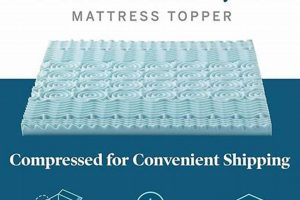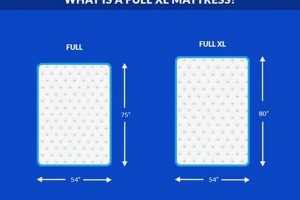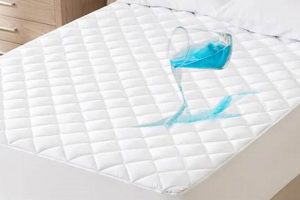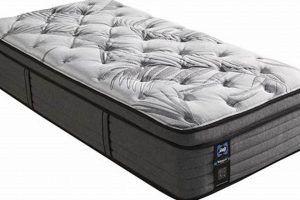The dimensions in question refer to a specific rectangular sleeping surface designed for individual use. It measures approximately 38 inches wide and 80 inches long. This format provides an additional five inches in length compared to its shorter counterpart, offering accommodation for taller individuals. As an illustration, a college dormitory often utilizes this dimension to comfortably house students in limited space.
The advantages of this configuration stem primarily from its extended length. This feature caters to the comfort needs of taller sleepers who might otherwise find themselves cramped on a standard-length bed. Historically, this adaptation arose in response to increasing average heights within the population and the need for a practical solution in environments like college residences and guest rooms where maximizing space is paramount. The elongated form contributes to improved sleep quality by allowing for full body extension, reducing pressure points and promoting relaxation.
Understanding the unique proportions of this sleeping surface is essential when considering its suitability for various applications. The following sections will delve into compatible bedding options, frame considerations, and the overall appropriateness of this form factor for different age groups and living situations.
Considerations for Twin XL Mattress Selection
Selecting the correct dimensions for a sleeping platform is crucial for optimizing comfort and maximizing available space. The following points outline critical factors to consider before purchasing a unit of the specified dimensions.
Tip 1: Measure the Intended Space: Prior to purchase, accurately measure the area where the bed will be placed. A unit of this size, while compact, still requires adequate clearance for movement and surrounding furniture. Failure to account for spatial constraints may result in an inconvenient arrangement.
Tip 2: Evaluate Sleeper Height: The primary advantage of this form factor is its extended length. If the intended user is of average or below-average height, a standard-length model may suffice. However, for individuals exceeding six feet in height, the extra length provided by this model offers significantly improved comfort.
Tip 3: Research Bedding Availability: Ensure that appropriate bedding, including sheets, comforters, and mattress protectors, is readily available in the specified dimensions. While widely accessible, variations in sizing can exist between manufacturers. Verifying compatibility before purchase avoids potential inconvenience.
Tip 4: Assess Frame Compatibility: Confirm that the existing or intended bed frame is designed to accommodate the specified dimensions. While many frames are adjustable, some are specifically designed for standard dimensions. Incompatible frames will provide inadequate support and may damage the mattress over time.
Tip 5: Consider Intended Use: Evaluate the intended purpose of the bed. This size is well-suited for individual use, particularly in dormitories, guest rooms, or smaller apartments. However, for couples or individuals desiring greater sleeping space, larger dimensions may be more appropriate.
Tip 6: Evaluate Mattress Type: The specific form factor is available in a variety of types, including innerspring, memory foam, and hybrid designs. Consider individual preferences and sleeping habits when selecting a particular construction. Trial periods, if available, can be invaluable in determining the optimal choice.
Implementing these considerations can ensure that the purchase of this size sleeping unit aligns effectively with individual needs and spatial constraints. Careful planning mitigates the risk of dissatisfaction and maximizes the benefits of the investment.
The subsequent sections will further explore the practical applications and optimal user profiles for the specified bed size.
1. Dimensions (38" x 80")
The measurements of 38 inches by 80 inches are definitive characteristics of the configuration in question. These values dictate the mattress’s physical footprint and directly influence its suitability for various applications and user profiles.
- Spatial Accommodation
The specified dimensions determine the area required to accommodate the bed. The 38-inch width and 80-inch length are crucial for space planning in bedrooms, dormitories, and guest rooms. For instance, a room measuring 10 feet by 12 feet can comfortably house this bed size alongside other essential furniture, maintaining adequate circulation space. This consideration is particularly important in compact living environments where maximizing usable area is paramount.
- Sleeper Comfort and Ergonomics
The 80-inch length provides extended legroom, benefiting taller individuals. This extra length is the key differentiator compared to a standard twin and is essential for comfortable sleep, preventing feet from hanging off the edge. For example, an individual taller than six feet is more likely to experience improved sleep quality on a twin XL due to this extended length.
- Bedding and Accessory Compatibility
The 38-inch by 80-inch dimensions necessitate appropriately sized bedding. Sheets, comforters, and mattress protectors specifically designed for this are readily available, ensuring a proper fit and preventing discomfort. Using standard-sized twin sheets on a twin XL, for example, would result in insufficient coverage, compromising comfort and protection.
- Frame and Foundation Requirements
The defined measurements dictate the required bed frame or foundation dimensions. A frame designed for this size ensures proper support and prevents mattress sagging or damage. A smaller frame, such as one designed for a standard twin, would provide inadequate support, potentially reducing mattress lifespan and sleeper comfort.
These dimensional attributes collectively define the practicality and suitability of the sleeping surface. While seemingly simple, these measurements have significant implications for space utilization, sleeper comfort, and compatibility with related accessories. Understanding these relationships is essential for informed purchasing decisions and optimized sleep environments.
2. Dorm Room Standard
The adoption of specific sleeping surface dimensions within dormitory settings is not arbitrary. A convergence of factors has led to the widespread acceptance of particular sizes as the “dorm room standard.” This standardization directly relates to space optimization, cost efficiency, and student comfort.
- Space Optimization
Dormitories are often characterized by limited square footage. Standardizing to a smaller sleeping surface allows institutions to accommodate a greater number of students within a given space. For instance, using larger beds would necessitate fewer beds per room, increasing housing demand and potentially leading to shortages. Space efficiency also factors into furniture placement and overall room functionality.
- Cost Efficiency
Bulk purchasing of beds and bedding in standardized sizes results in significant cost savings for institutions. Manufacturing efficiencies and economies of scale contribute to lower per-unit expenses. For example, sourcing custom-sized mattresses and linens would substantially increase operational costs. This consideration is particularly relevant for publicly funded institutions with budgetary constraints.
- Logistical Simplicity
Managing a large volume of standardized items streamlines logistical operations. Inventory control, bed assignment, and maintenance are simplified when all units adhere to the same specifications. Consider the complexity of managing bedding for multiple bed sizes; standardization eliminates this logistical hurdle and reduces the likelihood of errors.
- Height Accommodation
While prioritizing space, institutions also seek to provide adequate comfort for students of varying heights. The specified dimensions offer a compromise, providing sufficient length for a significant portion of the student population while maintaining a manageable footprint. For example, while some taller individuals may still prefer a larger bed, the extended length, compared to its shorter counterpart, often proves satisfactory.
These considerations demonstrate that the prevalence of specific dimensions in dorm rooms is a strategic decision driven by practical necessities. The dimensions balance spatial efficiency with student comfort and institutional cost-effectiveness. Consequently, students entering these environments should expect to encounter these accommodations as the norm.
3. Taller Individual Comfort
The correlation between the dimensions of a sleeping surface and the comfort experienced by taller individuals is a crucial consideration in mattress selection. The dimensions of the sleeping surface directly impact spinal alignment, pressure distribution, and overall sleep quality, particularly for those exceeding average height.
- Extended Legroom and Spinal Alignment
For taller individuals, inadequate mattress length can result in compromised spinal alignment. Limbs may hang off the edge, creating pressure points and disrupting natural sleeping posture. The specific length provides sufficient legroom to maintain a neutral spine, alleviating discomfort and promoting restorative sleep. A body that is not in contact with the mattress is unsupported and can lead to back pain and discomfort.
- Pressure Distribution and Circulation
The ability to fully extend on a sleeping surface facilitates even weight distribution. This reduces concentrated pressure on specific areas of the body, enhancing circulation and minimizing the likelihood of numbness or tingling. A surface that is too short forces a curled position, constricting blood flow and potentially causing discomfort.
- Enhanced Sleep Quality and Reduced Disruption
By accommodating the physical needs of taller individuals, the specified length contributes to improved sleep quality. Fewer positional adjustments and reduced discomfort result in deeper, more restful sleep. This directly impacts daytime alertness, cognitive function, and overall well-being. Inconsistent sleep creates sleep deprivation, which can impact mood, memory, and attention.
- Psychological Comfort and Restful Perception
Beyond purely physical considerations, the perception of adequate space fosters a sense of relaxation and security. Taller individuals often experience heightened anxiety in confined spaces, translating to sleep disturbances. The added length provides a psychological sense of spaciousness, promoting relaxation and improving the overall sleep experience. This also includes mental and emotional health.
These interwoven factors underscore the importance of considering the dimensional needs of taller individuals when selecting a mattress. The particular dimensions provide a targeted solution, enhancing comfort, promoting restful sleep, and supporting overall well-being by addressing specific physical and psychological requirements.
4. Space Efficiency
The configuration is commonly selected where spatial economy is paramount. Its dimensions strike a balance, offering sufficient sleeping area while minimizing the overall footprint. This attribute is particularly relevant in environments with limited square footage.
- Room Layout Optimization
Utilizing this dimension facilitates more flexible room layouts. The reduced width, compared to larger bed sizes, permits greater maneuverability within the space and allows for the incorporation of additional furniture pieces. For instance, in a small bedroom, a full-size bed might restrict the placement of a desk or dresser, whereas this specific sleeping surface enables a more functional arrangement.
- Multi-Use Space Accommodation
The dimensions in question are conducive to creating multi-functional living spaces. In studio apartments or shared living arrangements, every square foot must be carefully utilized. This bed size allows for the integration of sleeping and living areas without excessively compromising available floor space. For example, a living room might incorporate a daybed in these dimensions, serving as both seating during the day and a sleeping surface at night.
- Storage Integration
The compact form factor of this unit allows for the incorporation of integrated storage solutions. Bed frames with built-in drawers or under-bed storage compartments are readily available, maximizing vertical space and minimizing clutter. This feature is particularly valuable in small apartments or dorm rooms where closet space is limited. Such a design provides a discreet and efficient means of storing bedding, clothing, or other personal items.
- Easy Maneuverability and Transport
Compared to larger beds, units of this scale are easier to maneuver and transport. This is advantageous in situations involving frequent relocation, such as college students moving between semesters or individuals renting temporary accommodations. The reduced size simplifies the process of moving the bed into and out of tight spaces, minimizing the risk of damage to the bed or surrounding structures.
The enumerated facets illustrate the distinct spatial advantages associated with this particular bed size. Its suitability for limited spaces, multi-functional arrangements, and integration with storage solutions highlights its value in environments where space efficiency is a primary concern. These factors contribute to its widespread adoption in diverse living arrangements.
5. Bedding Availability
The connection between the dimensions and the accessibility of appropriately sized bedding is significant. The availability of sheets, comforters, mattress protectors, and other bedding accessories designed specifically for this configuration directly impacts the practicality and user satisfaction of owning one. When bedding is readily available, consumers can easily find products that fit properly, ensuring comfort, hygiene, and protection of the mattress investment. This aspect elevates the appeal and functionality of the specific product in question. A lack of appropriately sized bedding creates inconvenience and compromises the overall sleeping experience. Consider, for example, a college student purchasing a twin XL mattress only to discover that the selection of affordable, stylish sheets is limited compared to standard twin sizes. This scenario underscores the importance of a robust bedding market for this format.
The cause-and-effect relationship is clear: The existence of a popular mattress size drives demand for corresponding bedding, prompting manufacturers to produce and distribute these products. Conversely, limited bedding options can negatively affect the perceived value and adoption rate of the mattress. Practical significance arises from the fact that bedding is not merely an aesthetic addition but also a functional necessity. Well-fitting sheets contribute to sleep comfort, while mattress protectors safeguard against spills, stains, and allergens, extending the lifespan of the mattress. A comprehensive market for bedding accessories enhances the long-term value proposition for consumers. Moreover, many online retailers will promote the sale of these mattresses to encourage the sale of the compatible bedding options.
In summary, the ample availability of bedding accessories designed for the dimensions is integral to the overall consumer experience. This factor influences purchase decisions, impacts user satisfaction, and contributes to the long-term value and utility of the sleeping surface. Challenges arise when specific types of bedding, such as organic cotton sheets or specialized mattress protectors, are scarce or expensive in this size. Addressing these gaps in the market would further solidify the configuration as a viable and desirable option for a broader range of consumers.
6. Frame Compatibility
The correlation between frame dimensions and the physical dimensions of a Twin XL mattress is a critical determinant of stability, support, and longevity. Incompatibility between frame and mattress introduces the risk of structural damage, reduced sleep quality, and potential safety hazards.
- Dimensional Accuracy
A frame intended for the specified mattress must adhere precisely to the dimensions of 38 inches by 80 inches. Deviations, even minor ones, can compromise support and lead to premature mattress wear. For instance, a frame that is slightly too short will cause the mattress to sag at the foot, while one that is too narrow will leave gaps along the sides, potentially causing instability.
- Support Structure Integrity
The frame’s internal support structure, whether it consists of slats, springs, or a solid platform, must be robust enough to bear the weight of the mattress and its occupant(s). Insufficient support will result in sagging, uneven weight distribution, and decreased comfort. An example of insufficient support would be a frame with widely spaced slats, which allows the mattress to sink between them.
- Headboard and Footboard Attachment
If a headboard or footboard is desired, the frame must be designed with appropriate attachment points and dimensions to accommodate these components securely. Incompatible attachment points can lead to instability or structural failure. The headboard or footboard may separate from the frame if not properly aligned.
- Material Durability and Construction Quality
The materials used in the frame’s construction, as well as the overall quality of workmanship, directly influence its ability to withstand long-term use and maintain dimensional integrity. Inferior materials or poor construction practices can lead to warping, cracking, or joint failure, compromising the frame’s ability to adequately support the Twin XL mattress. The fasteners are crucial, if they become loose, this creates instability.
The proper selection of a frame that is dimensionally accurate, structurally sound, and compatible with desired accessories is essential for maximizing the lifespan and performance of a Twin XL mattress. Neglecting these considerations can result in discomfort, premature mattress degradation, and potential safety risks.
Frequently Asked Questions
This section addresses common inquiries regarding the specified mattress dimensions, providing clarity and dispelling misconceptions.
Question 1: What are the precise dimensions of a twin XL mattress?
A twin XL mattress measures 38 inches in width and 80 inches in length. These dimensions are standardized across most manufacturers, though slight variations may exist.
Question 2: Is a twin XL mattress larger than a standard twin?
Yes, it is larger than a standard twin mattress. While both share the same width (38 inches), the twin XL has an additional 5 inches in length, measuring 80 inches compared to the standard twin’s 75 inches.
Question 3: What type of bed frame is required for a twin XL mattress?
A bed frame specifically designed for twin XL mattresses is necessary. Standard twin frames will not adequately support the length, potentially causing damage to the mattress. Adjustable frames labeled as compatible with twin XL dimensions are also suitable.
Question 4: Where are these mattresses most commonly used?
These mattresses are frequently found in college dormitories and guest rooms due to their space-saving design and suitability for individual sleepers, particularly those of taller stature. They can also be found in other small space enviornments.
Question 5: Are twin XL sheets interchangeable with standard twin sheets?
No, sheets designed for standard twin mattresses are not compatible with twin XL mattresses. The additional length requires sheets specifically labeled for twin XL dimensions to ensure a proper fit.
Question 6: What is the weight capacity of a twin XL mattress?
Weight capacity varies depending on the construction and materials used in the mattress. Consult the manufacturer’s specifications for precise weight limits. Exceeding the stated capacity can compromise the mattress’s support and longevity.
These FAQs provide a foundational understanding of matters relating to the specific product. For additional information, consulting manufacturer specifications or sleep product experts is recommended.
The subsequent section will explore comparisons between the product and other mattress sizes, offering insight into suitability across various user profiles and living arrangements.
In Conclusion
This exploration has delineated the specific attributes of the twin xl mattress size, encompassing its dimensions, suitability for dormitories, accommodation of taller individuals, space efficiency, bedding availability, and frame compatibility. Understanding these factors is crucial for making informed purchasing decisions and optimizing sleep environments.
The twin xl mattress size presents a strategic solution for specific needs. Its advantages and limitations should be carefully weighed against individual requirements and spatial constraints. Further research into individual mattress types and materials is encouraged to ensure optimal comfort and long-term satisfaction.


![Best Twin XL Pillow Top Mattress [2024 Guide] Organic & Natural Mattress Buyer’s Guide: Non-Toxic Sleep Solutions Best Twin XL Pillow Top Mattress [2024 Guide] | Organic & Natural Mattress Buyer’s Guide: Non-Toxic Sleep Solutions](https://mattressworldpa.com/wp-content/uploads/2025/07/th-873-300x200.jpg)




